Video of the Week:
Pruning Grape Vines
Vegetables:
Time to Plant Potatoes Approaching
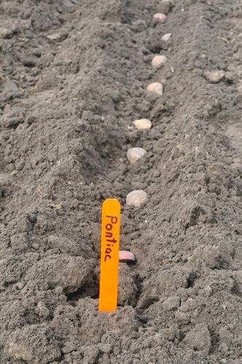
Each seed piece should be between 1.5 and 2 ounces and include at least one eye to ensure there is enough energy for germination. Each pound of potatoes should yield 8 to10 seed pieces. Cut the seed 2 to 3 days before planting so freshly cut surfaces have a chance to suberize, or toughen, and form a protective coating. Storing seed in a warm location during suberization will speed the process. Plant each seed piece about 1 to 2 inches deep and 8 to 12 inches apart in rows. Though it is important to plant potatoes in March, emergence is slow. It is often mid- to late-April before new plants poke their way through the soil. As the potatoes grow, pull soil up to the base of the plants. New potatoes are borne above the planted seed piece, and it is important to keep sunlight from hitting the new potatoes. Exposed potatoes will turn green and produce a poisonous substance called solanine. Keeping the potatoes covered will prevent this. (Ward Upham)
Rhubarb
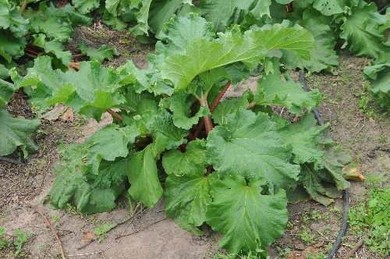
Also, have a soil test done as rhubarb does best with a pH below 7.0.
Rhubarb should be planted from mid-March to early April in Kansas. Mix 5 to 10 pounds of well-rotted barnyard manure into the soil for each 10 square feet of bed before planting.
Rhubarb is propagated from crowns (root sections) that contain one or two buds. Plants should be spaced 2 to 3 feet apart in the row with 4 to 5 feet between rows. The crowns are planted shallow so that the buds are just one-half to 1 inch below the soil surface. Firm soil around the crowns and make sure they are not in a depression that holds water. Recommended varieties include Canada Red, Crimson Red, McDonald and Valentine.
Rhubarb needs rejuvenated at least every 5 to 10 years and should be dug and divided in the same time period as new plantings are established. Use a cleaver or axe to cut crowns into sections that each contain one or two buds. Plant as described above.
Newly transplanted rhubarb should not be harvested the first year so the plant can recover from the transplant process. Only a few stalks should be harvested the second year to allow the plant to continue to build up its energy reserves. The harvest season for plants that are three years or older usually lasts about 8 weeks. Harvest only the largest and best stalks by pulling them slightly to the side so that they break away from the plant. Never harvest over one-third of the leaf stalks at one time. Only the leaf stalk (petiole) is eaten as the leaf blade contains oxalic acid and is poisonous.
Mulches can be used to reduce moisture loss, prevent weed growth and provide winter protection. However, it should be pulled away in the spring to allow the soil to warm so that early growth is encouraged. (Ward Upham)
Fruit:
Pruning Raspberries and Blackberries
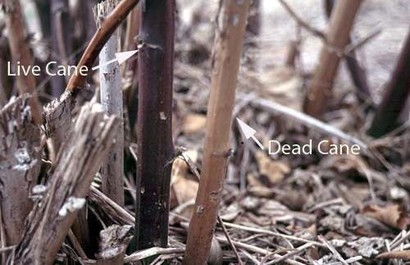
Dead canes are not difficult to identify. They are a much lighter color than live canes and are dry and brittle. These canes should be removed and discarded. The remaining canes should be thinned but the type of growth determines exactly how this should be done.
Black and purple raspberries and thornless blackberries tend to grow in a clump. Remove all the canes but 5 to 7 of the largest and healthiest in each clump. Cut back the remaining canes to living tissue if there was winter damage. Thornless blackberries will also produce a few suckers that come up some distance from the clump. These should be removed or dug and transplanted to increase the planting.
Red raspberries and thorny blackberries sucker badly and will fill the row with new plants. Prune out small canes within the row so that there are strong canes 4 to 6 inches apart. Head back all the remaining canes to about 5 feet. Keep aisles free of new suckers during the summer by mowing.
We now have what is called ever-bearing red raspberries and everbearing thorny blackberries. These are the exception to the rule in that they will bear fruit on first-year canes. Therefore, you can cut all canes to the ground in the winter and still have fruit. Examples include Heritage red raspberry and Prime-Jim, Prime-Jan, Prime Ark 45 and Prime Freedom blackberries. For more detail and line-drawings that illustrate pruning techniques, see our publication titled, “Raspberries and Blackberries” at http://www.ksre.ksu.edu/bookstore/pubs/mf720.pdf. (Ward Upham)
Strawberry Mulch Removal
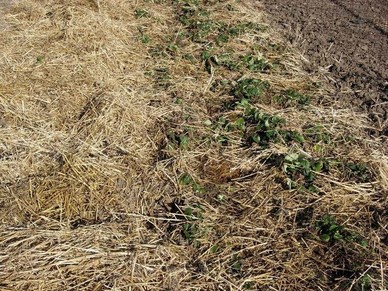
Do not completely remove all the straw as there are likely to be freezing temperatures that can injure or kill blossoms. Keep the mulch between rows to conveniently recover the berries when freezing temperatures are predicted. Also, remove only enough mulch that the leaves peak through. The remaining mulch will help keep berries from rotting due to contact with the soil. (Ward Upham)
An Old-Time Concoction for Mildew Control on Peach
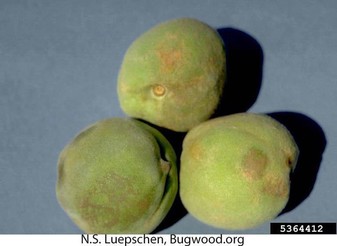
Mix 26 gallons of urine with 6.5 gallons of pigeon dung and allow to ferment for 48 hours. Then add 2.2 pounds of aconite (Monk’s Hood) branches and 3.8 gallons of water. Apply mixture to peach leaves. A single application in April was said to provide year-long control.
We have not done any efficacy studies, nor do we plan to. The preceding was from a fascinating book titled, “The Truth About Garden Remedies” by Jeff Gillman. (Ward Upham)
Turfgrass:
Nightcrawlers in the Lawn
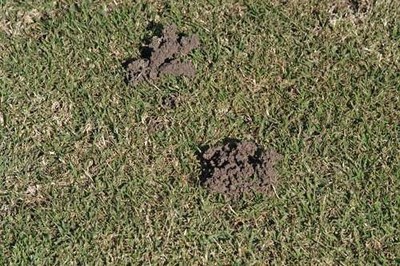
Nightcrawlers are large worms -- usually 4 to 8 inches or more. They belong to a group of earthworms known as deep-burrowers. The deep-burrowers build large, vertical, permanent burrows that may reach as deep as 5 or 6 feet.
Nightcrawlers pull plant material down into their burrows to feed on later. The bumps you see on top of the ground are called "middens" and are a mixture of plant residues and castings (worm feces). These middens may be used for protection and food reserves. The burrows can have a significant positive effect on soil by opening up channels for water and air to penetrate. Roots also like these channels because they ease root penetration and supply nutrients from the casting material lining the burrow. The middens, however, are a source of aggravation for homeowners. They can make it hard to mow or even walk on a lawn because they become very hard when they dry.
Getting rid of the middens is difficult. Rolling the lawn while the middens are soft may help temporarily, but mounds will be rebuilt when nightcrawlers become active again. Also, there is nothing labeled for nightcrawler control.
Some gardeners want to protect the nightcrawlers because of their positive effect on soils. Pesticides that may be used for other pests vary widely in their toxic effects on earthworms. One that has no effect is Dylox (Proxol). Malathion may be slightly toxic while Sevin and copper are extremely toxic. Avoid using the latter group while nightcrawlers are active. (Ward Upham)
Contributors: Ward Upham, Extension Associate
 RSS Feed
RSS Feed
